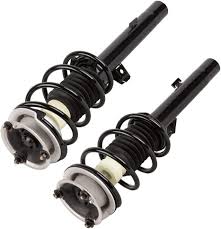The suspension system of your car is critical to delivering a smooth and controlled ride. Among its important components are shocks and struts, which are responsible for absorbing road bumps and vibrations. These car components, like most critical car parts can deteriorate over time, impacting the vehicle’s handling, safety, and overall performance. The rate of wear is affected by a variety of factors, including road and weather conditions, driving style, and vehicle load. In this blog post, we’ll look at the indicators of worn-out shocks and struts to help you determine whether it’s time for a shocks and struts replacement.
Excessive Bouncing:
Excessive bouncing is one of the most visible indications of worn-out shocks and struts. When driving over bumps or uneven terrain, your vehicle should rebound once and stabilize. If you see your car bouncing excessively, it’s a sign that the shocks and struts are no longer efficiently reducing suspension movement.
Poor Steering Response:
Worn-out shocks and struts might have a detrimental impact on the steering response of your vehicle. If you notice that the steering wheel is less responsive or that the car sways or wanders while turning, it could be due to faulty suspension components. This loss of control is hazardous, especially during rapid maneuvers. Also, when driving on a bumpy road, it is normal to feel some vibration in your steering wheel. If you feel comparable vibrations on calm roads, your shocks, struts, or steering stabilizer may be worn.
Uneven Tire Wear:
The condition of your car tires can provide valuable insights into the health of your suspension system. If you detect uneven car tire wear, such as bald spots or irregular patterns, it could be because the shocks and struts are not effectively keeping the tires in contact with the road surface. This reduces car tire longevity and jeopardizes the vehicle’s overall stability.
Dips or Nose Dives During Braking:
Shocks and struts play an important role in the braking performance of your vehicle. When applying the brakes, worn-out components may cause severe nosediving or dipping- when your car dips towards the ground when you hit your brakes. This can lead to increased stopping distances, less braking efficiency, and a less enjoyable driving experience.
Knocking or Clunking Noises:
Unusual noises, such as clunking or knocking, can indicate a problem with your shocks and struts. When driving over bumps, potholes, or difficult terrain, these noises may occur. Such sounds indicate that the suspension components are no longer providing adequate cushioning and are enabling metal-to-metal contact.
Car Fluid Leaks:
Hydraulic fluid is used to absorb vibrations in shocks and struts. If you observe car oil or car fluid leaks around these suspension components, it is a clear indication that they are no longer properly holding the fluid. Car fluid leaks not only reduce the efficacy of the shocks and struts, but they can also cause other mechanical problems if not rectified.
Conclusion:
Regular inspection and repair of your vehicle’s suspension system, especially the shocks and struts, is critical for a safe and comfortable driving experience. Being watchful and swiftly addressing signs of worn-out shocks and struts can help prevent future damage, improve vehicle safety, and extend the life of your vehicle. If you notice any of the above symptoms, contact a professional for a complete check and, if necessary, immediate replacement of worn-out shocks and struts.




